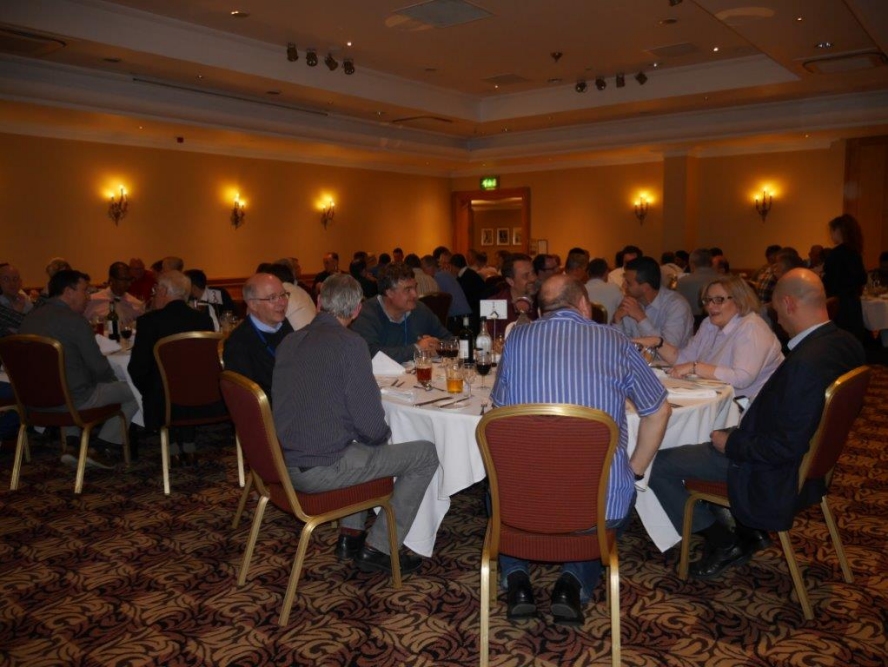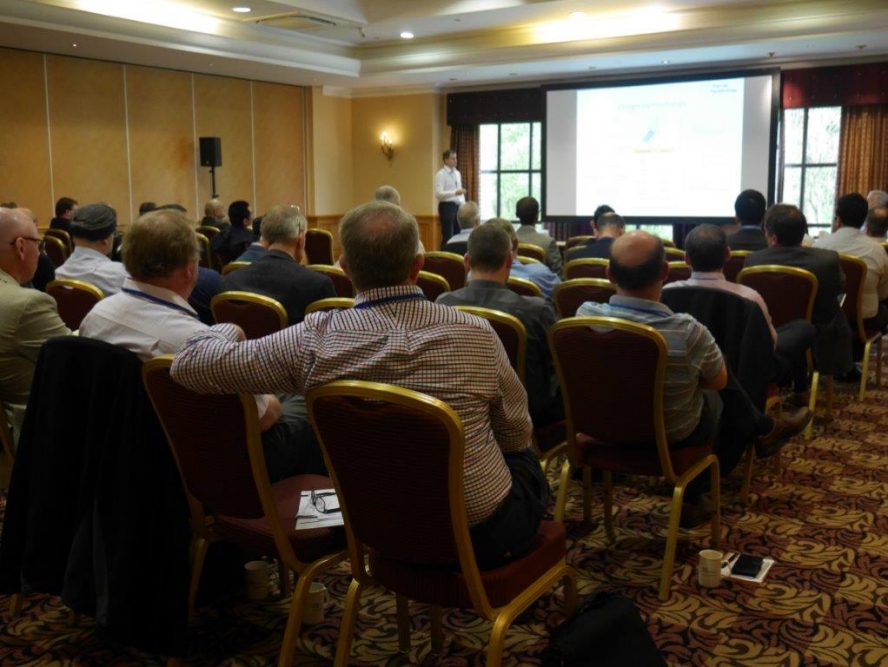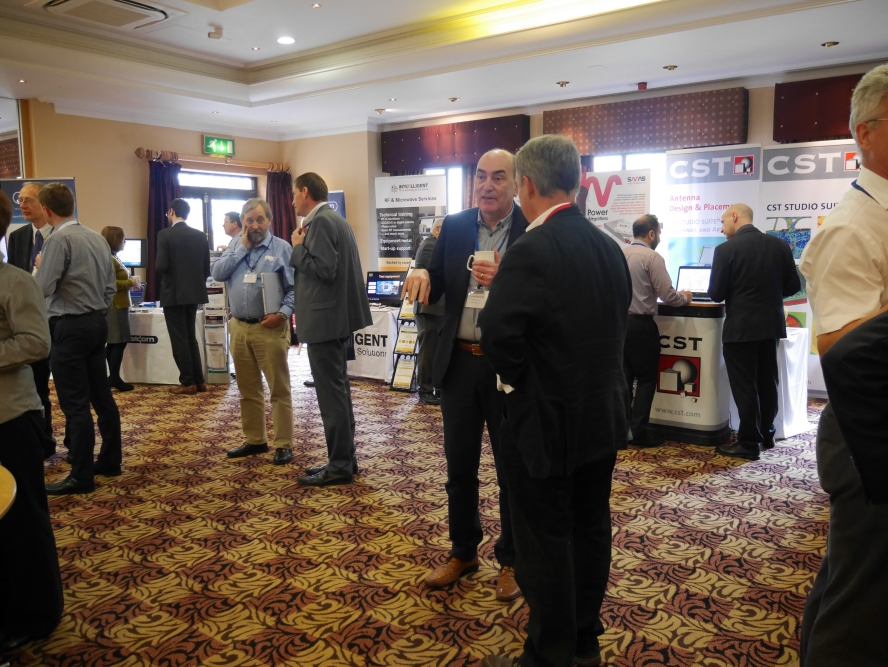The April 2016 took pace at the Oxford Belfry. The Steve Evans-Pughe prize for the best paper (sponsored by NI) was awarded to William Otter (co-authors Nick Ridler and Stepan Lucyszyn ). The runner-up was Yi Wang.
Young Engineer Sponsorship: The ARMMS RF & Microwave Society offers sponsorship to young engineers (28 or below) who have papers accepted for presentation. Sponsorship is £100 cash plus free attendance (including conference dinner and overnight accommodation). Potential candidates should identify themselves as eligible at time of submission and state their date of birth. This offer is limited to a maximum of 2 places per meeting.
Best Paper Award: The Steve Evans-Pughe prize is awarded to the best presenter at each meeting. The award is £200 for the best paper and £50 for the runner-up. The prize is sponsored by AWR.
For exhibition enquiries please email exhibition@armms.org, for all other enquiries please email enquiries@armms.org
 |  |  |
The Oxford Belfry
Milton Common
Nr Thame
Oxfordshire
| Tel | 01844 279 381 |
| Web | http://www.qhotels.co.uk/our-locations/the-oxford-belfry/ |
David Hand
Northrop Grumman
Park Air Systems Ltd
A 2.5 W LDMOS Microwave Totem-Pole Push-Pull RF Power Amplifier | |
| Gavin Watkins | |
| Toshiba Research Europe Ltd | |
RF push-pull power amplifiers (PA) typically use a transformer or balun at the output to combine the two anti-phase signals. The push-pull PA described here does not, instead using a totem-pole output stage consisting of two N-channel FETs; a source-follower to supply current to a 50Ω load, and a common-source amplifier to sink current. The source tab of the source-follower cannot be grounded to dissipate heat in the normal way, so a ceramic spacer transfers the heat to an aluminium heatsink. A prototype PA was designed for 700 MHz. Under continuous wave (CW) excitation, it achieved a 1 dB compression point (P1dB) of 33.9 dBm (2.46 W) at an efficiency of 46.5%. The second harmonic distortion (HD2) suppression was 43.6 dB relative to the fundamental. These results indicate that the PA was operating in a push-pull mode. | |
| A 2.5 W LDMOS Microwave Totem-Pole Push-Pull RF Power Amplifier | |
A Very High Efficiency High Power Schottky Diode Frequency Doubler Operating at 180-190 GHz | |
| Tomasz Waliwander | |
| Farran Technology | |
This paper presents simulation and test results for a fixed-tuned ultra-high efficiency high power Schottky diode 180-190 GHz frequency doubler. The doubler was designed for an input power of 100-200 mW and tested producing flange-to-flange peak efficiency greater than 40% and output power greater than 70 mW in 185-195 GHz band. The 3 dB bandwidth was measured at more than 13%. In terms of output power and total efficiency these results exceed the current state of the art at the given frequency and input power. | |
| A Very High Efficiency High Power Schottky Diode Frequency Doubler Operating at 180-190 GHz | |
Convergence of Simulation and Measurement Worlds in the Modern Era | |
| Alistair Wingfield | |
| CST AG - Computer Simulation Technology | |
In today’s era, EM simulation is now part and parcel of the product lifecycle management for many manufactured electrical/electronic goods. For most application requirements, regardless of electrical size, there exists a numerical technique that aids in the development, design and certification. In some cases a single solver is not adequate and a combination of different numerical techniques can be employed to a problem to obtain an optimised goal. However the key question is still the same after more than 25 years of simulation development regardless of the design at hand: “Will my simulation be accurate enough and have good correlation with the expected measurements/ outcome?” This paper looks at a couple of diverse examples where simulation and measurements have converged in an increasingly complex and sophisticated world, and some of the considerations required. It also looks at how the ethos of the simulation models has adapted to modern management. | |
| Convergence of Simulation and Measurement Worlds in the Modern Era | |
Design of Ultra Broadband Highly Efficient GaN Power Amplifiers Using Voronoi Diagrams | |
| Yuan Zhuang | |
| University of Liverpool | |
This paper presents the design, implementation and experimental results of a broadband high-efficiency GaN-HEMT power amplifier. The proposed method defines the optimal impedance regions of a PA at several frequency steps across the operational band. Those regions contain the impedance that maintains high output power and high power added efficiency (PAE) levels simultaneously. The source-pull and load-pull simulations are employed to determine the optimal input and output impedance of a GaN transistor across 0.3-2.3 GHz regarding PAE and output power level. A low-pass matching network is applied to implement the optimal impedance over the band. The measurement results indicate a power of gain better than 10 dB and a typical output power of 43 dBm. The measured PAE is 58%-69% across a 7.6:1 bandwidth. | |
| Design of Ultra Broadband Highly Efficient GaN Power Amplifiers Using Voronoi Diagrams | |
High Power GaN Amplifier for High Efficiency Applications | |
| Avtar Virdee | |
| Microwave Technology | |
Design and measured results of a single stage S-Band high-efficiency GaN-HEMT power amplifier is presented for continuous wave (CW) applications. The power amplifier employs Class-F harmonic processing technique to shape the current and voltage waveforms to enhance the amplifier’s efficiency performance. The GaN-HEMT device constituting the amplifier is a commercial off-the-shelf device that is designed for high voltage operation. The fabricated GaN-HEMT power amplifier operating under continuous wave mode achieved a nominal gain of 18 dB with an output power of 130 Watts, a drain efficiency of 73%, and power-added efficiency (PAE) of 64% across 2.35 to 2.55 GHz. | |
| High Power GaN Amplifier for High Efficiency Applications | |
Hybrid 3-D Printing Technology for Tunable THz Applications | |
| William Otter | |
| Imperial College London | |
In recent years, additive manufacturing has experienced rapid growth, due to its inherent capabilities for creating arbitrary 3-D structures, accessibility, and associated low manufacturing costs. This paper first reviews the state of the art in 3-D printing for terahertz (THz) applications and identifies the critical features required for such applications. The future potential for this technology is demonstrated experimentally with the first 3-D-printed, optically controlled THz IQ vector modulator. Here, miniature high-resistivity silicon implants are integrated into metal-pipe rectangular waveguides. The 3-D-printed split-block assembly also houses two packaged infrared laser diodes and a heat sink. The measured performance of a proof-of-principle 4-quaternary amplitude modulation (4-QAM) vector modulator that operates up to 500 GHz is reported. This new hybrid 3-D printing THz technology, which combines semiconductor devices with potentially low-cost, high-performance passive guided-wave structures represents a paradigm shift and may prove to be an ideal solution for implementing affordable transceivers in future ubiquitous THz applications. | |
| Hybrid 3-D Printing Technology for Tunable THz Applications | |
Integrated Multi-Role Microwave Antennas and Passive Circuits | |
| Dr Yi Wang | |
| University of Greenwich | |
This talk will discuss a relatively new microwave device concept - the so-called ‘multi-role device’ where multiple circuit functions are combined and integrated in one component. It will focus on two topics that have been in the research front in the past few years: integrated filtering antennas and multi-port filtering networks. | |
| Integrated Multi-Role Microwave Antennas and Passive Circuits | |
Laboratory Scale Equipment for Microwave Pyrolysis of Waste Petrochemical Based Products | |
| John McGreevy | |
| Sylatech | |
The decomposition of hydrocarbons by elevated temperatures in an inert atmosphere is a well understood process within chemistry. In recent years there has been a developing interest in the process to recycle waste hydrocarbon based materials. Conventionally furnaces have been used to heat the materials, however over the last decade small industrial facilities have been constructed that heat the waste using microwave energy. Pyrolysis as a recycling process is economically justifiable if the value of the products recovered plus any reduction in taxes and tariffs are intrinsically more valuable than the installation and running costs of the facility. To understand the economic value of the end products of the waste materials a laboratory scale equipment has been developed. The equipment consists of two 1 kW cw magnetrons connected to a microwave chamber which takes small samples of waste materials, typically in the range of 50 to 100 grams and heats the samples by means of the microwave energy in an inert atmosphere. The resulting hydrocarbon gases, liquids and solids are then collected and analysed. This paper discusses the equipment details and shows results from the microwave pyrolysis of waste rubber and ashphaltene. | |
| Laboratory Scale Equipment for Microwave Pyrolysis of Waste Petrochemical Based Products | |
Linearisation of RF Front Ends | |
| Gareth Lloyd | |
| Rohde and Schwarz | |
Linearization, as a concept for improving signal integrity in radios, has been around for the best part of 100 years (at least dating back to Black's Feedforward patent, filed in 1925). A golden period of innovation followed for 80 years, until the turn of the century, when the now quasi-ubiquitous DPD (digital pre-distortion) became the architecture of choice. It was adopted widely, no more so than in Mobile Communications. As a result, the subject matter has become somewhat neglected. This paper is intended to provide a broad grounding, introduction and refresher to the subject matter. To include the proposal of a classification system, a review of some key methods along with a statement of the limits and goals of linearization. | |
| Linearisation of RF Front Ends | |
Low Phase Noise Signal Sources for Radar and Instrumentation | |
| Dr Stuart Feeney | |
| SMF Designs Ltd | |
This paper describes the implementation of signal sources within the range 70 MHz to 7 GHz with very low in-band phase noise using combinations of direct, phase-locked and digital synthesis techniques. | |
| Low Phase Noise Signal Sources for Radar and Instrumentation | |
Magnetron Developments at e2v | |
| Dipendra Mistry | |
| e2v Technologies | |
Magnetrons were first developed to meet the demand for a high power, high frequency RF source in radar systems during WWII. Since this time, a significant amount of design innovation has taken place to improve device performance for a number of different applications. This paper will trace some of the key aspects of magnetron design, operating principles and technological developments which have led to their rapid adoption in medical and marine radar applications. The latest devices are the product of historic developments which have been realised through e2v’s heritage in vacuum electron tube devices. | |
| Magnetron Developments at e2v | |
Reconfigurable Hardware Design | |
| Adam Taylor | |
| Lincoln DSP Ltd | |
The timescales involved in delivering modern systems are decreasing, at the same time the complexity of these systems is increasing. To meet these challenges we need to be able to leverage not only design reuse but also highly flexible reconfigurable devices and supporting eco systems. Reconfigurable hardware provides the user with two potential use cases
On way, a reconfigurable hardware platform is achieved is by the use of technologies such as System on Chip (SoC) which combine ARM cores with programmable logic. These devices provide a wide range of Industry standard interfaces SPI, I2C, Gigabit Ethernet which can be used and enabled / disabled as the application requires. While the on board programmable logic enables interfacing to high performance devices such as, (ultra) wideband ADC, DAC and Image Sensors. This paper will look at these devices, some of the architectures which can be used to create flexible hardware and the surrounding eco systems which can be used create and leverage these re configurable systems. | |
| Reconfigurable Hardware Design | |
The Digital IFM Revisited | |
| S. V. Potter | |
| - | |
Naval Electronic Warfare receivers have evolved greatly since the beginning of World War 2. As WW2 progressed, the capability and size of the combatants created a need for more sophisticated EW Systems; greater sensitivity, better selectivity and better identification of signal sources were called for. The situation is much the same now. Today, signal density can be a problem and certain types of signal can significantly degrade receiver performance. This paper identifies some of the shortcomings of the older type of IFM in a modern environment and suggests a way in which a phased array based receiver can achieve simultaneous measurement of RF frequency and angle of arrival. Each element of the array feeds a phase discriminator. Highly redundant processing is employed to ensure the discriminators track correctly in the presence of significant manufacturing errors and receiver noise. | |
| The Digital IFM Revisited | |
The Trouble with Oscilloscope Probes | |
| Mark Ashcroft | |
| Picotech | |
The low cost hand-held oscilloscope probe has changed very little in the last three or four decades, arguably it has “lost touch” with its applications as signals have become faster, smaller and more prone to the invasive nature of their measurement. This paper reviews the rapidly growing scale of the problem and proposes a more appropriate design approach to achieve a microwave and Gigabit test probe. | |
| The Trouble with Oscilloscope Probes | |
Two Port Gain and Stability | |
| Dave Andrews | |
| Vectawave | |
The fundamental requirements for stability of a 2 port network is described. This is investigated by way of device gain and the concept of gain circles, using the S parameter formulation. The requirements in terms of a device’s S parameters are described. Those in circulation for a long time are confirmed as valid, as well as a more recent and concise single form. | |
| Two Port Gain and Stability | |
Companies booking two or more delegate places are able to take part in the commercial exhibition that accompanies the conference. Please note: there is a maximum of 20 exhibition tables at each meeting, these are offered on a first come basis. Booking two delegate places does not guarantee an exhibition space, please email exhibition@armms.org to check availability and reserve and exhibition space.
The Society would like to thank Saras Technology for sponsoring the April 2017 meeting:
Contributions are invited with an emphasis on RF and microwave design, research, testing and associated subjects. An oral presentation will be made at the meeting and a written paper will be required for publication in the society digest, which is distributed to delegates at the meeting. Prospective speakers are requested to submit a title and a short abstract to the technical coordinator (see above) as soon as possible.
Click here to view our Guidelines for Authors
Click here to view our Publication Release Form